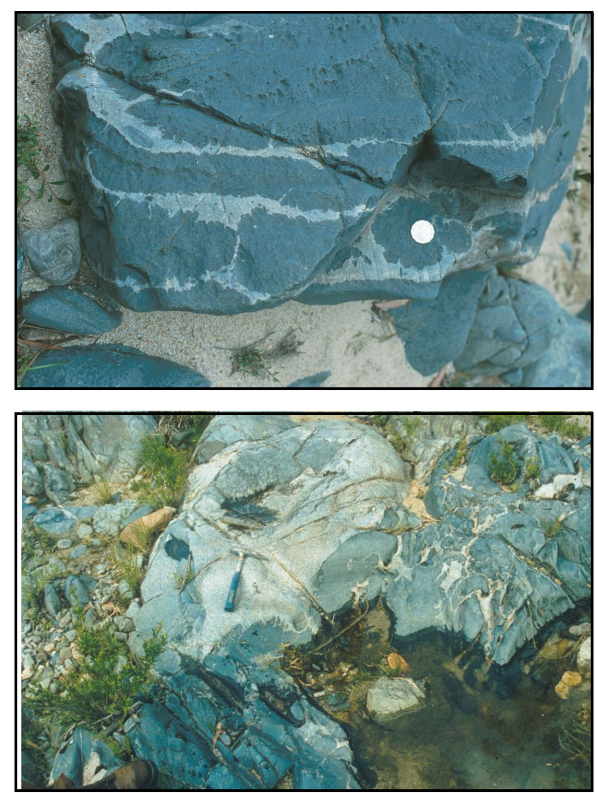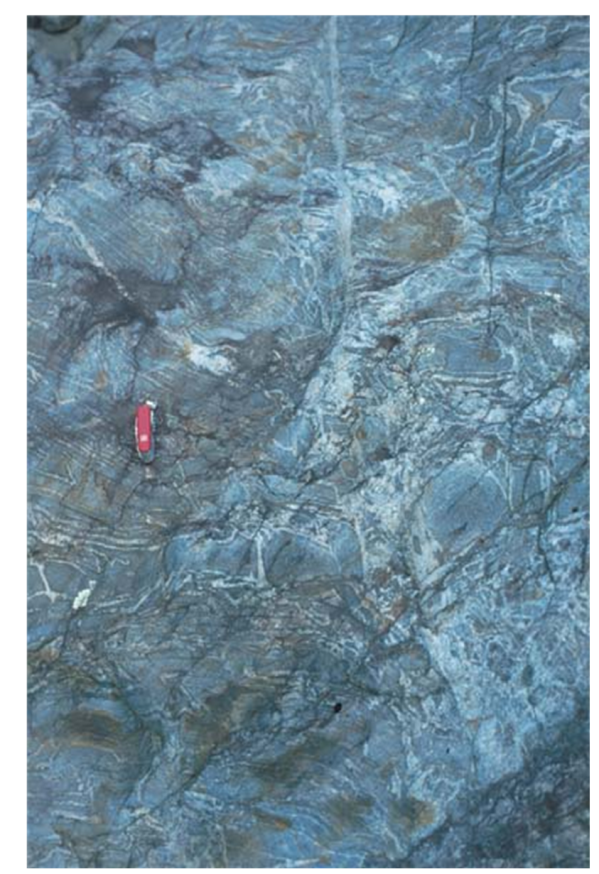Stop 2 - Top of WWMC
Several km downstream from the "type locality", the upper contact of the WWMC is exposed (Figure 18). It consists of dyke-and sheet-Iike mafic bodies that are sub-concordant with bedding in migmatised, quartz-rich metasedimentary rocks. These metre-scale thick intrusives have amalgamated to form the gabbro complex, much like at the "type locality". Other similarities include chilled bases and rip-up clasts, and weakly-developed graded units. However, the major difference is the localised mixing and mingling with felsic material.
The uppermost 10 metres of the main WWMC unit consist of fine-to medium-grained, layered mafic rocks that are extensively intruded and partially hybridised with a fine microgranite (Figure 19b). This unit forms narrow discordant, curved (folded?) veins with local sharp contacts against the chilled gabbro, but elsewhere the contacts are diffuse and the rock is transitional to intermediate, heterogenous fine-grained hybrid rocks that are aligned concordantly with the gabbroic layers. The veins also contain small tine-grained (chilled) enclaves of gabbro. Elsewhere, larger mafic pillows are enclosed in granitic layers which are sub-concordant with the gabbroic sheets (Figure 19a).
Figure 18. Map of rock-type relations at the top of the WWGC

Map of rock-type relations at the top of the WWGC.
At another locality, a south-trending network of granite veins rapidly diminish to tine stringers which spread E-W (laterally) against the overlying, fine-grained (chilled) mafic layer (Figure 19b). This layer appears to have been an impenetrable barrier to underlying, rising granitic melts. Thus, the granitic magma has intruded into the WWMC and hybridised along the less crystallised, more differentiated layers of the complex, indicating a coeval relation between mafic and silicic units at the top of the complex.
Figure 19ab. Rock detail

a) Vein network of granite enclosing “pillows” of medium -coarse grained gabbro. b) Chilled, crenulate contacts of Pericoe granite against WWGC.
Figure 19c.

c) Injection of leucosome in the sub-vertical axial plane of syn-migmatitic F3 folds. Injection of leucosome along S3 has isolated migmatitic blocks, forming diatexitic breccia.
Intrusive sheets and lenses of Pericoe and aplitic granite are also sub-concordant with the WWMC contact. Pericoe intrusions are typically lense-Iike, and commonly form a border between the migmatitic metasediments and WWMC. The aplitic veins generally post-date the Pericoe granite, as they contain rare fragments of the granite and locally cut granitic veins. However, some contacts between the two are gradational. Sharp contacts of Pericoe granite along the upper contact of the main WWMC, indicates that it generally post-dates solidification of the gabbro. However, in some places, pillow-like gabbroic WWMC enclaves within Pericoe granite, with either chilled on crenulate contacts (Figure 19b), show that the granitic and basaltic magmas were coeval, at least locally.
The last intrusive phase at this location is a 4-metre wide, discordant, N-trending, basaltic dyke which abruptly terminates in the quartzitic metasediments. A narrow stringer of the dyke continues southward for ~10 metres, but most stringers have propagated sub-parallel to bedding. This is an example of the transitional basalt dykes of Middle Devonian age, which cut the entire Bega Batholith. Similar dykes will be encountered downstream.
Several metres above the main contact, m-wide lenses of gabbro, up to 8 m long, are isolated within the migmatitic quartz-rich metasediments. These disrupted dykes are characterised by "pinch-and-swell" features, with the dykes "necking" within one metre to thicknesses of cm-scale. The lack of strong fabric development in the lenses or adjacent quartzites suggests that the "boudinage" occurred while the dykes were in the magmatic state, and the metasediments were migmatitic. Directly above the "boudinaged" dykes, a 2-3 m wide dyke/sheet of gabbro within the metasediments is broken in to angular blocks, separated by thin felsic veinlets of aplite, Pericoe granite and felsic hybrids. An unusual vein of coarse aplite, grading to pegmatite, cuts the dyke but also forms concordant pod-like structures, which appear to be small diapirs that have partly ascended through the overlying mafic magma. These appear to have been silicic melts that were present in the countryrock during the late stage stages of deformation.
Approximately 40 metres above the WWMC contact, the migmatised metasedimentary rocks are much more pelitic and exhibit markedly different character from their quartz-rich counterparts. Whereas the psammites occur as semi-concordant layers, the metapelite layers are broken into jumbled fragments within leucosome, and resemble a "breccia" (Figure 19c).
The leucosome appears to be originally K-feldspar and cordierite rich, but have been strongly retrogressed to muscovite-chlorite intergrowths. Locally, a narrow (mm-scale) halo of coarse mica rims the pelitic fragments. It resembles melanosome in regional migmatites, and could be a back-reaction product, implying that the water-rich, early melt phase did not escape from the site of partial melting. Alternatively, it is a reaction halo, suggesting that the pelite fragments are not in equilibrium with the leucosome, which was derived externally. Which alternative is correct?